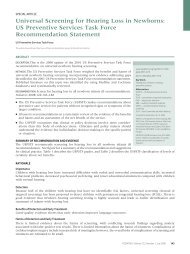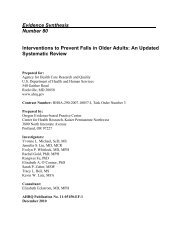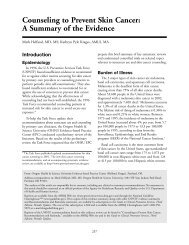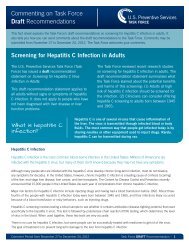Screening for Depression in Adult Patients in Primary Care Settings ...
Screening for Depression in Adult Patients in Primary Care Settings ...
Screening for Depression in Adult Patients in Primary Care Settings ...
You also want an ePaper? Increase the reach of your titles
YUMPU automatically turns print PDFs into web optimized ePapers that Google loves.
Cl<strong>in</strong>ical Guidel<strong>in</strong>es <strong>Primary</strong> <strong>Care</strong> <strong>Screen<strong>in</strong>g</strong> <strong>for</strong> <strong>Depression</strong> <strong>in</strong> <strong>Adult</strong>s<br />
Table. Summary of Results <strong>for</strong> KQ1 and KQ1a: Studies Exam<strong>in</strong><strong>in</strong>g Health Outcomes of <strong>Screen<strong>in</strong>g</strong> Results Feedback Among<br />
<strong>Screen<strong>in</strong>g</strong>-Identified Depressed <strong>Patients</strong> <strong>in</strong> <strong>Primary</strong> <strong>Care</strong><br />
Study, Year (Reference) Sett<strong>in</strong>g Approach to Intervention<br />
Beyond <strong>Screen<strong>in</strong>g</strong><br />
Results Feedback<br />
General adult population<br />
Williams et al, 1999 (21) Multisite, Veterans Affairs,<br />
community health cl<strong>in</strong>ic<br />
impossible to determ<strong>in</strong>e, however, what role the screen<strong>in</strong>g<br />
component played <strong>in</strong> the success of their program. Furthermore,<br />
although this <strong>in</strong>tervention was proven feasible<br />
<strong>for</strong> primary care sett<strong>in</strong>gs, it <strong>in</strong>volved substantial <strong>in</strong>stitutional<br />
commitment and may not reflect the care that would<br />
be found currently <strong>in</strong> most sett<strong>in</strong>gs.<br />
Older <strong>Adult</strong> Populations<br />
In screen<strong>in</strong>g focused on older adults, 4 fairly large-scale<br />
trials (24, 25, 28, 29) screened 12 432 primary care patients to<br />
identify 1443 depressed older adults to test the effect of<br />
Sample Characteristics<br />
None (KQ1: <strong>in</strong>cluded unscreened control group) 863 participants; 71% women; calculated<br />
age, 58 y; proportion treated, not reported<br />
Bergus et al, 2005 (26) Rural None 59 participants; 67% women (calculated);<br />
calculated age, 41 y; 38% received<br />
medication <strong>for</strong> depression or anxiety<br />
Jarjoura et al, 2004 (27) Urban, <strong>in</strong>digent Improve quality of provider’s care; logistic<br />
support <strong>for</strong> provider; other staff provide some<br />
depression care<br />
Wells et al, 2000 (23) and<br />
2004 (30); Sherbourne et al,<br />
2001 (31)<br />
Rost et al, 2001 (22) and<br />
2000 (32); cases <strong>in</strong> which<br />
depression was identified by the<br />
provider as part of usual care<br />
be<strong>for</strong>e the study<br />
Rost et al, 2001 (22), 2000 (32),<br />
and 2002 (33); cases <strong>in</strong> which<br />
depression was newly identified<br />
by screen<strong>in</strong>g related to the<br />
study<br />
Multisite, urban, rural Improve quality of provider’s care; logistic<br />
support <strong>for</strong> provider; other staff provide some<br />
depression care<br />
Multisite, urban, rural Improve quality of provider’s care; logistic<br />
support <strong>for</strong> provider; other staff provide some<br />
depression care<br />
Multisite, urban, rural Improve quality of provider’s care; logistic<br />
support <strong>for</strong> provider; other staff provide some<br />
depression care<br />
61 participants; 69% women (calculated);<br />
calculated age, 45 y; 0% currently treated<br />
1356 participants; 71% women; age 44 y;<br />
proportion treated, not reported<br />
243 participants; 84% women‡; age 43 y‡;<br />
100% recently treated<br />
189 participants; 84% women‡; age 43 y‡;<br />
0% recently treated<br />
Older adult population<br />
Bosmans et al, 2006 (28) Urban, the Netherlands Improve quality of provider’s care 145 participants; 60% women; calculated<br />
age, 65 y; 0% currently treated; 83%<br />
history of depression<br />
Whooley et al, 2000 (24) Urban Improve quality of provider’s care; other staff<br />
provide some depression care (m<strong>in</strong>imally<br />
implemented)<br />
Callahan et al, 1994 (25) Urban Improve quality of provider’s care; logistic<br />
support <strong>for</strong> PCP<br />
Rubenste<strong>in</strong> et al, 2007 (29) Urban, Veterans Affairs Logistical support <strong>for</strong> PCP; other staff provide<br />
some depression care<br />
331 participants; 61% women; calculated<br />
age, 76 y; 20% received antidepressants<br />
<strong>for</strong> �12 mo<br />
175 participants; 76% women; age 65 y;<br />
11.4% received antidepressants<br />
792 participants (206 screened positive <strong>for</strong><br />
depression); 3.2% women; age 74 y;<br />
proportion treated, not reported<br />
CES-D � Center <strong>for</strong> Epidemiological Studies depression scale; CIDI � Composite International Diagnostic Interview, full <strong>in</strong>terview; CIDI-2 � Composite International<br />
Diagnostic Interview, 2-item depression screen; DIS � diagnostic <strong>in</strong>terview schedule <strong>for</strong> Diagnostic and Statistical Manual of Mental Disorders, Third Edition Revised; GDS �<br />
Geriatric <strong>Depression</strong> Scale; HDRS � Hamilton <strong>Depression</strong> Rat<strong>in</strong>g Scale; IV1� psychotherapy, IV2 � medication support; IV � <strong>in</strong>tervention; KQ � key question; MADRS<br />
� Montgomery–Asberg <strong>Depression</strong> Rat<strong>in</strong>g Scale; MDD � major depressive disorder; PCP � primary care provider; PHQ-9 � Patient Health Questionnaire-9 item;<br />
PRIME-MD � <strong>Primary</strong> <strong>Care</strong> Evaluation of Mental Disorders, Mood Module screen<strong>in</strong>g items; UC � usual care; Z-BDI � Beck <strong>Depression</strong> Inventory, standardized on<br />
control group change.<br />
* P �0.05.<br />
† P �0.01.<br />
‡ These statistics refer to the entire study sample.<br />
§ Results <strong>for</strong> the 2 <strong>in</strong>tervention groups were reported comb<strong>in</strong>ed at 6- and 12-mo follow-up. They were reported separately at 24- and 57-mo follow-up.<br />
Reported that groups did not differ at 6 or 9 mo, but did not provide exact scores.<br />
** Results only <strong>for</strong> subgroup that screened positive <strong>for</strong> depression.<br />
screen<strong>in</strong>g feedback with some care supports on remission and<br />
symptom reduction. Only 1 of 4 <strong>in</strong>terventions <strong>in</strong> these trials<br />
improved depression beyond usual care (29). This trial attempted<br />
to identify patients with any of 5 high-risk conditions,<br />
1 of which was depression. It <strong>in</strong>volved the assistance of<br />
a case manager, who conducted an <strong>in</strong>-depth assessment and<br />
then referred the patient to primary or specialty care or to a<br />
multidiscipl<strong>in</strong>ary geriatric assessment team <strong>for</strong> further assessment.<br />
The case manager also provided patient education and<br />
follow-up. After 1 year, there was a 1-po<strong>in</strong>t difference <strong>in</strong> im-<br />
796 1 December 2009 Annals of Internal Medic<strong>in</strong>e Volume 151 • Number 11 www.annals.org









